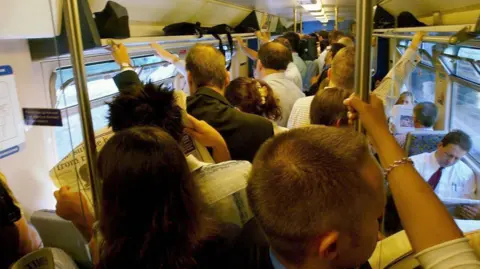 PA Media
PA MediaOne in five rail passengers arriving into major cities in England and Wales during the morning rush hour were forced to stand, official figures show.
The average number of commuters pouring into urban centres on a daily basis rose by 13% to 1.7 million on average between September and December 2023, compared to the same period the year before.
But train operators increased seating capacity by just 2% over that time, according to a report published by the Department for Transport (DfT).
Alex Robertson, chief executive at Transport Focus, the watchdog said: “Our research shows that getting a seat is in the top five priorities of what passengers want from the railway.
“This will need to be considered alongside other priorities for investment as demand continues to increase.”
‘Bunfight’
 Emma Haslett
Emma HaslettMatt Picton is a regular commuter from Newcastle to London. He said that although the commute into the capital tends to be quiet, the return journey can be a “bunfight”.
“If there’s a cancelation, then you’ve got two lots of people trying to get on one train, and you have the bunfight of who’s booked which seat,” he said.
“My worst experience was having to stand all the way from Kings Cross to Newcastle, which is about three hours, give or take.”
 Emma Haslett
Emma HaslettKaren Rudge, an accountant, commutes from Letchworth about once a month, and said she doesn’t always have to stand on her 30-minute commute, but it does happen.
“It’s frustrating when you’ve got to then go and do a full day’s work,” she said.
“Plus, I’m really short, so if I’m standing with lots of people, I tend to feel quite claustrophobic.”
But Israel Obinusi, who was returning to Sheffield from London on Thursday after he took an exam, said his journey had been “pleasant”.
“The expectation I had was met. It’s never been awful,” he said.
And Jess Leyland, an interior designer from Wakefield, said the key is to book a seat.
“Usually people are quite courteous,” she said. “If you’ve got a reservation, they’ll be ok with that.”
Changing habits
Of the largest cities, London saw the highest number of arrivals during the period, at a daily average of 1.1 million which was a 14% increase on the same time the previous year.
It is about 10 times higher than Birmingham, the city with the next-highest number of people travelling in every day at 108,400.
But while the mornings on trains in London were busy last year, they were not as crowded as pre-Covid travel.
The figures indicate that people’s travel habits have changed since the pandemic, with more passengers arriving outside the morning peak.
In autumn 2019, 55% of London-bound passengers came in between 7am and 10am. By 2023, that proportion had dropped to 45%.
However, people are continuing to return to their workplaces.
Stripping out the effect of the Elizabeth Line, which was launched in 2022, the figures show that the number of arrivals into major cities in England and Wales dropped by just 73,000, or 4%, between autumn 2019 and autumn 2023.
A spokesperson for the DfT said: “We are bringing operators back under public ownership and leading the biggest overhaul of our railways in a generation.”







